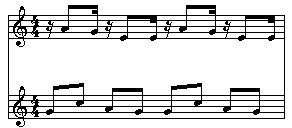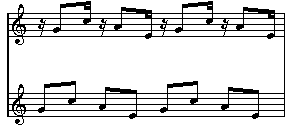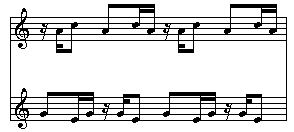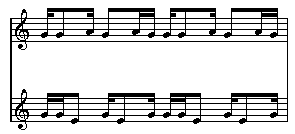Issue 9, Fall 2006: Indonesian Gamelan
Welcome to the World Rhythms News, an infrequent newsletter dedicated to world music education. This issue uses President George W. Bush's foray into the wonderful world of Indonesian gamelan to suggest exercises to develop interlocking rhythm skills. To subscribe, use the form below. Follow instructions thereafter, and make sure to check "World Music Education" in the "Interests" section of the sign up process.
In this issue:
Indonesian Gamelan
Bush Beats Gamelan (You Can Too!)
A gamelan is an Indonesian ensemble normally composed primarily of percussion. These orchestras typically include tuned gongs, bronze kettles, bronze metallophones, bamboo xylophones, drums, cymbals, flutes, and bowed string instruments. While the music itself is complex, some of the instruments do not require a great deal of technique to play, as President Bush found out in his November 16, 2006, visit to Singapore, in which he was treated to a performance of Asian fusion ("coincidentally" the name of Ancient Future's sixth CD, Asian Fusion) music by a group called "Gamelan Asmaradana." The musicians played a classical Javanese piece and a Singapore folk song. Invited to play himself, Bush kneeled on the carpet, beat the saron (a metallophone) with a rubber mallet for a time, and then said: "I'm going to quit while I'm ahead."However, this is one area where he should be encouraged to stay the course rather than to cut and run. After all, his first performance was greeted with applause by the members of the gamelan orchestra. It is as if all the success that was predicted for his Iraq invasion is now coming true for him in the wonderful world of gamelan.
Daily Show Video
Balinese Gamelan
These exercises are examples from Balinese gamelan music. In Bali, orchestras of tuned gongs, bronze kettles, bronze metallophones, bamboo xylophones, drums, cymbals and flutes fill the night air with animated music. Melodic parts interlock, divided in such a way that musicians play alternate notes to form the melody line. These interlocking parts, known as kotèkan, require cooperation and a keen sense of rhythm to perform.
Knowledge of kotèkan can be extremely valuable. These interlocking rhythms have a unique way of bringing people together in cooperation towards a common goal, which President Bush could certainly benefit from. Some critics of his policies have said they would like to send him to Mars, and indeed he has proposed going there. But this seems a drastic and expensive solution, particularly considering that a music sabbatical to Bali for the purpose of studying these wonderful interlocking parts could have a profound effect on his international diplomacy skills. He has already shown some interest. This could be a true hidden talent just waiting to come out.
The two parts of a kotèkan, which are thought of as male and female, are known as nyangsih and polos. The main accents of the male nyangsih part are usually on the offbeat, while the main accents of the female polos part are usually on the beat. The male instruments are slightly higher in pitch to produce a chorusing effect. There is no interlocking between the male instruments or the female instruments, only between the male and female instruments. This should fit in well with Bush's philosophy of the sanctity of heterosexual marriage. In all of the standard Western music notation examples below, the polos (female) is on the bottom staff while the nyangsih (male) part is on the top.
Kotèkan Types
These examples are from Ancient Traditions--Future Possibilities, Chapter 2, Exercise II, page 49. There are four types of melodic kotèkans recognized in North Bali: chandetan, tutugan, ochètan, and semi- ochètan.
Chandetan
![]() MIDI
MIDI
The chandetan is an alternating rhythm in which the nyangsih melody differs from the polos. This might be considered the musical equivalent of a partisan showcase, but where the result still works to the benefit of all:

Tutugan
![]() MIDI
MIDI
The tutugan is an alternating rhythm in which the nyangsih melody follows the polos. This might be the musical equivalent of what Bush is hoping for in bipartisan cooperation:

Ochètan
![]() MIDI
MIDI
The ochètan is an interlocking rhythm in which two separate voices are created where the parts meet. This is likely the musical equivalent of what the Democrats hope for in bipartisan cooperation:

Semi-Ochètan
![]() MIDI
MIDI
The semi-ochètan is an interlocking rhythm in which the parts meet on a unison, which is probably the musical equivalent of what voters hope for in bipartisan cooperation:

Gamelan Anklung
The gamelan anklung is a four-tone ensemble that commonly accompanies temple ceremonies. This is an intermediate level kotèkan from Ancient Traditions--Future Possibilities, Chapter 2, Exercise III D, page 51:

This kotèkan was used as the basis for the composition Gamarock from the Ancient Future release Dreamchaser. ![]() .
.
Another example of the contemporary use of the kotèkan concept can be found in the song Semara from Planet Passion. ![]() .
.
World Rhythm Training Manual
A good resource that President Bush could use in preparation of his trip to Bali to learn Balinese gamelan rhythms is the book Ancient Traditions--Future Possibilities. The above rhythms are from the audio guide tracks to this "world beat bible" by Matthew Montfort, leader of the popular world fusion music ensemble, Ancient Future. The book takes the student on a musical voyage through the traditions of Africa, Bali, and India with a series of exercises that require no instruments to perform. A must-have for all students of world music:
Ancient Traditions -- Future Possibilities: Rhythmic Training Through the Traditions of Africa, Bali and India. By Matthew Montfort. Kentfield: Ancient Future Music, 1985. ISBN 0-937879-00-2. Comb Bound Book, $33.95 (SALE! Normally $46.95): Add 1 to Cart. Buy 1 Now. Book/Enhanced 2 Audio CD Set with MIDI Soundfiles:$53.95 (SALE! Normally $74.95): Add 1 to Cart. Buy 1 Now.
The rhythms are now also available in audio format:
Ancient Rhythms--Future Grooves: MIDI Percussion Groove Tracks from the Traditions of Africa, Bali, and India PLUS Complete 2 CD Set of Audio Guide Tracks . By Matthew Montfort. Ancient Future Music (2005). Companion 2 Volume Enhanced Audio CD set with MIDI Soundfiles, 28.95 (SALE! Normally $39.95): Add 1 to Cart. Buy 1 Now. A complete 2 CD set of audio guide tracks PLUS a CD-ROM presentation of MIDI files based on the book Ancient Traditions--Future Possibilities.
This two CD/CD-ROM set of 115 audio tracks for playback on standard CD players and 128 MIDI files helps reinforce the material in the book and insures practicing correctly and in rhythm. Volume I and covers the exercises in the West Africa and Bali chapters of the book. Volume II covers the exercises in the India and Future Possibilities chapters. The General MIDI sound files of the exercises in the book can be used with a web browser for playback, or can be loaded into a MIDI sequencer for greater control. Change the tempo, listen to individual parts, or remap the sounds to different MIDI instruments. The CD-ROM even includes MIDI maps of West African, Balinese, and Indian percussion sound assignments enable custom remapping to your patches and instructions to turn your sequencer into a tabla machine using VSTi plug-ins and included tabla samples.
All compositions, recordings, video, and text in this article © 20xx Ancient Future Music. All rights reserved.

